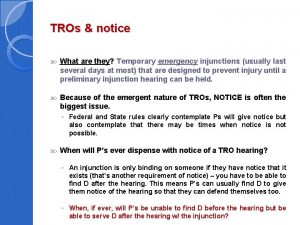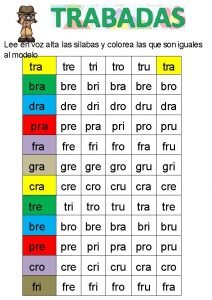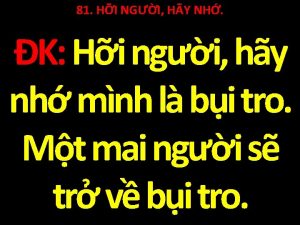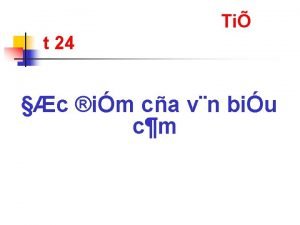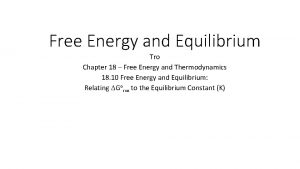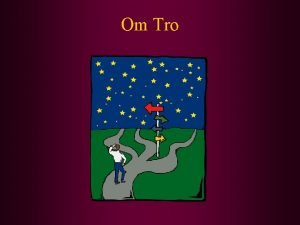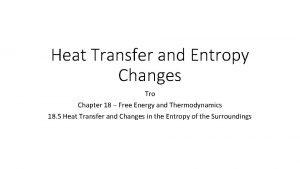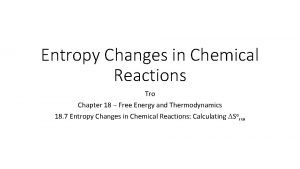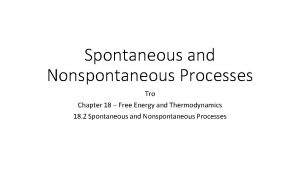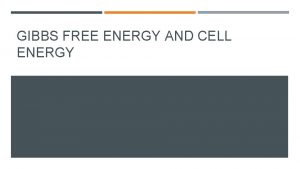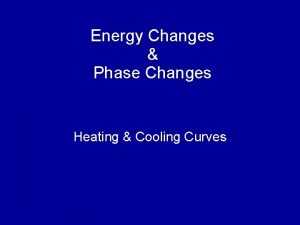Free Energy Changes Tro Chapter 18 Free Energy














- Slides: 14

Free Energy Changes Tro Chapter 18 – Free Energy and Thermodynamics 18. 8 Free Energy Changes in Chemical Reactions: Calculating DGorxn

Calculating DG from DH and DS Consider the decomposition of phosgene, COCl 2(g) CO(g) + Cl 2(g) • Calculate the DHo and DSo at 25 o. C for this reaction. • Calculate the value of DGo at 25 o. C. • If DH and DS do not change with temperature, what is the value of DG at 800 o. C? Substance ΔHfo So ΔGfo (k. J/mol) (J/mol K) (k. J/mol) COCl 2 (g) − 219. 1 283. 5 − 204. 9 CO(g) − 110. 5 197. 7 − 137. 2 Cl 2(g) 0 223. 1 0 Remember DG = DH – TDS

Standard Free Energies of Formation • The free energy of formation (DGf°) is the change in free energy when 1 mol of a compound forms from its constituent elements in their standard states. • The free energy of formation of pure elements in their standard states is zero.

Calculating DGo from Free Energies of Formation One method for synthesizing methanol (CH 3 OH) involves reacting carbon monoxide and hydrogen gases: CO (g) + 2 H 2 (g) CH 3 OH (l) Calculate ΔGo at 25 o. C for the reaction. Substance CH 3 OH (l) CO (g) H 2 (g) ΔGf˚ (k. J/mol) -166 -137 0

A chemical engineer wants to determine the feasibility of making ethanol (C 2 H 5 OH) by reacting ethylene (C 2 H 4) and water according to the reaction: C 2 H 4 (g) + H 2 O (l) C 2 H 5 OH (l) Is the reaction spontaneous? Substance C 2 H 5 OH (l) C 2 H 4 (g) H 2 O (l) ΔGf˚ (k. J/mol) -175 -237 68

DG from Stepwise Reactions • If a reaction can be expressed as a series of reactions, the sum of the DG values of the individual reaction is the DG of the total reaction. – DG is a state function. • If a reaction is reversed, the sign of its DG value reverses. • If the amount of materials is multiplied by a factor, the value of the DG is multiplied by the same factor. • The value of DG of a reaction is extensive.


Use the following data at 25 ˚C to calculate ΔG˚ for the reaction: Cdiamond (s) Cgraphite (s) ΔG˚ = ? Given: Cdiamond (s) + O 2 (g) CO 2 (g) ΔG˚ = -397 k. J Cgraphite (s) + O 2 (g) CO 2 (g) ΔG˚ = -394 k. J

Why Free Energy Is “Free” • The free energy is the maximum amount of energy available to do work. • For many exothermic reactions, some of the heat released due to the enthalpy change goes into increasing the entropy of the surroundings, so it is not available to do work. • And even some of this free energy is generally lost to heating up the surroundings.



Free Energy and Reversible Reactions • The change in free energy is a theoretical limit as to the amount of work that can be done. • If the reaction achieves its theoretical limit, it is a reversible reaction.

Real Reactions • In a real reaction, some (if not most) of the free energy is “lost” as heat. • Therefore, real reactions are irreversible.

Calculate the ΔH◦, ΔS◦, and ΔG◦ for the reaction C(graphite) + H 2 O(g) CO(g) + H 2(g) Determine the temperature where this reaction becomes spontaneous. Substance ΔHfo (k. J/mol) So (J/mol K) ΔGfo (k. J/mol) C (graphite) 0 5. 7 0 H 2 O (g) − 241. 8 188. 8 − 228. 6 CO(g) − 110. 5 197. 7 − 137. 2 H 2(g) 0 130. 7 0
 Gibbs free energy equation
Gibbs free energy equation Gibbs free energy vs standard free energy
Gibbs free energy vs standard free energy Ln ksp vs 1/t
Ln ksp vs 1/t Helmholtz free energy
Helmholtz free energy Elizabeth mulroney
Elizabeth mulroney Examples of chemical change
Examples of chemical change Notice tro
Notice tro Con dra dre dri dro dru
Con dra dre dri dro dru Prefix multipliers
Prefix multipliers Introductory chemistry 5th edition nivaldo j. tro
Introductory chemistry 5th edition nivaldo j. tro Bài 2 cải tạo tu bổ vườn tạp
Bài 2 cải tạo tu bổ vườn tạp Hỡi người hãy nhớ mình là bụi tro
Hỡi người hãy nhớ mình là bụi tro Hãy tìm mạch ý của bài văn hoa học trò
Hãy tìm mạch ý của bài văn hoa học trò Giải phương trình bậc 1 sql
Giải phương trình bậc 1 sql Trò chơi khuông nhạc bàn tay
Trò chơi khuông nhạc bàn tay






